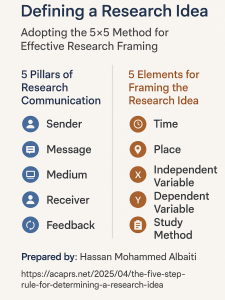Written by: Professor Hassan Mohammed Al-Bayti
Founder of the Academic News Network and Akapress, an academic advisor and university lecturer at the American University of the People and the Islamic University of Minnesota.
Date: Monday, Shawwal 23, 1446 AH, corresponding to April 21, 2025

Students are always confused about determining the research idea that they will start from towards writing the scientific paper. After 8 years of experience in writing and reviewing scientific papers, I found that the research idea follows specific criteria that I summarized in the five-rule rule, which I summarized in the equation 5*5.
Everyone knows that 5*5=25, and 25 here means 25 research ideas (at least) that can be derived according to the matrix system, but each of these five can produce more than 25 research ideas.
In general, we will begin to explain the meaning of the fifth with the mentioned equation as follows:
The first five (pillars of research communication): We mean by them five elements that must be known when thinking about the nature of research, and they are:
SenderWe mean the person who implements the research idea. The person who implements it may be one researcher or more than one.
messageHere, we mean the problem that the researcher will discuss. The problem may be one that has not yet been resolved, or one that has been resolved from a specific angle and abandoned from another. The problem may also be a model of human or mechanical work that has not yet been developed in a manner that is consistent with the requirements of the era.
The meansWe mean by this the tool that will be used to collect research data from the study sample according to the phenomenon to be studied and the form of the data (qualitative, quantitative). It may be in the form of questionnaires, content analysis of publications, documents, or papers, or conducting a scientific interview with experts, officials, and those affected by the study from the public, and finally scientific observation in its regular and irregular aspects.
the futureWe mean by this the importance of the study, as we show the future of the benefits of the study, and we show him the justifications for conducting the study.
Echo (feedback): These are the expected results of this study, which are related to achieving the study objectives.
The second five: (framing the idea): It complements the first five, and must be clear in the title of the study, in its methodology, and in its summary, and it is as follows:
Study timeIf we want to talk about the Japanese Z-management theory in developing production in Japan, we must limit the time period in which we want to talk about this matter, while clarifying the reason in the “justifications for conducting the study.” Let’s assume that we want to talk about this between the years “2021-2024.” For example, we mention in the justifications for conducting the study that this is due to the financial damages that Japanese companies suffered as a result of the Covid-19 pandemic. Then the study has a time justification.
noteAccording to international standards for scientific journals, previous studies mentioned in any research should not exceed 10 years, while for others, it should be five years. As for the theoretical framework, all studies can be included regardless of the year. However, the point of highlighting the subject of previous studies is that previous studies are the starting point for the researcher in designing a research idea that is different from what came before it. After mentioning all the research, the researcher justifies the differences between his study and a study before him. This justification is considered a notification to the scientific refereeing body that the research is unique.
Place of study: It is necessary to talk about the study in a place where the researcher can access information. For example, if we want to talk about management according to Taylor’s theory, which is concerned with production only without paying attention to people and their needs according to Maslow’s hierarchy, let us choose a country where this situation applies, and where we can access the companies’ database, or obtain the opinions of the respondents. It is not reasonable, for example, for the researcher to choose a country that speaks a language he does not master, or a country that imposes restrictions on the freedom of access to information, or a country that is difficult to access due to geographical distance, or that takes a long time to implement. The simplest example for us is the United States of America, which has 51 states, and it is difficult to cover all of them, so we must take only one state and apply the information to it.
Another example is that accessing data in North Korea is difficult due to the nature of the regime, which prohibits freedom of information.
A third example is for someone who wants to study the matter in a country in East or Central Africa, but is from the Asian continent. Here, they will encounter difficulties due to the geographical distance and the lack of databases in a country that has not kept up with technology, as is the case in some countries on the African continent.
independent variableIt is a factor that affects another factor and can be called (the cause). For example, if we study “the impact of the Corona pandemic on increasing the profits of delivery companies in 2020 in Saudi Arabia,” the Corona pandemic is considered an independent variable. It is possible to have multiple independent variables in a single study if the phenomenon to be studied is shaped by several factors. All of this is determined by the study hypothesis, its questions, or both. It is common in experimental studies, and it requires the use of statistical techniques to measure multiple variables.
dependent variableIt is a factor affected by another factor and can be called (the effect). An example of this is the previous statement: “Increasing profits for delivery companies.” It is possible to have multiple dependent variables in one study if the effects of the phenomenon are multiple and a comprehensive understanding of the phenomenon is desired, whether medical, social, or administrative. For example, the effect of job stress (an independent variable) on job satisfaction and productivity (two dependent variables), which are also determined through the study’s hypotheses, questions, or both.
noteIn the early stages of a researcher's career, it is preferable to address only one variable in each of the independent and dependent variables, and to deal with the study questions if the research is qualitative. However, if the research is quantitative, the hypotheses that require dealing with statistical equations are dealt with, in which statistical analysis programs are used, some of which are studied, such as the R program and the SPSS program.
Study methodologyThe type of curriculum is determined by the type of study itself, as follows:
Qualitative study: is a study that does not usually include quantitative data, and the study uses either the ethnographic method, the case study, phenomenology (studying the impact of the experience), grounded theory (developing a new theory from the data), action research, or narrative research.
Example: I conducted an action research study to solve practical problems in a real-life context. The title of the study was “Ways to adopt a culture of publishing preprints in the Arab scientific research communityIt was published in the Journal of Scientific Development for Studies and Research. In this study, I relied on practical solutions that were implemented after planning and evaluating the challenges. I mentioned in my analysis of previous studies that all scientific papers on the phenomenon under study relied on quantitative research.
To browse the study
Al-Bayti, Hassan. (2025). Methods of adopting a culture of publishing preprints in the Arab scientific research community. Journal of Scientific Development for Studies and Research, 6(21), 214-237. https://doi.org/10.61212/jsd/314
Quantitative studyIt is the study in which the researcher relies on quantitative data, and uses in conducting the study the method based on analyzing quantitative data according to its type: questionnaires with the descriptive method, documents with the historical method, medical, engineering and agricultural experiments with the experimental method, in addition to other methods, and under each method there are subgroups. The descriptive method includes the analytical, comparative and survey methods, and so on.
Example: Referring to the PrePrint phenomenon, which we addressed as a qualitative study, all the previous studies we addressed in the above-mentioned paper are quantitative in orientation, including:
Zayed, Nora. (2022). Al-Azhar University Faculty Members' Use of Preprint Servers Journal of the Humanities Sector, 29(1), 1327–1404. https://doi.org/10.21608/jsh.2022.242604
| Study analysis | Hassan Al-Bayti | Nora Zayed |
| Sender | One researcher | One researcher |
| message | Developing a model relevant to the phenomenon under study (qualitative research) | Identifying respondents' use of the model relevant to the phenomenon under study (quantitative research) |
| The means | Scientific observation and application | questionnaire |
| the future | Institutions and individuals in the scientific community | Al-Azhar University staff |
| Feedback | Design a scalable, updated model | Recommendations for future research |
| Time | Based on previous studies, the study of the phenomenon began in 2019. According to the references that the researcher needed in the theoretical framework, I present a reference that was published in 2001 because it is a comprehensive study. |
Based on the dependent variable or respondents, the study started from 2021 to 2022.
According to the references that the researcher needed in the theoretical framework, the oldest reference was published in 2014. |
| Place | Akapress Journal of Scientific Publishing in Yemen | Al-Azhar University in Egypt |
| independent variable | Ways to adopt culture Publish preliminary copies | Knowledge of pre-repositories |
| dependent variable | to publish Preprints in the Arab scientific community | Al-Azhar University faculty members' use of pre-repositories |
| Study methodology | Action research | Survey method |
Conclusion
After identifying all of the above, the student can easily formulate the research proposal and its title. This scientific basis is nothing more than the product of years of research studies, as I found that most books discuss explaining scientific research methods, and did not address explaining the formation of the scientific research idea and its framework except in rare cases.
I hope that this matter will develop and become a matter of interest to researchers and authors, and that the five-point rule will develop in a way that serves the scientific research community.




